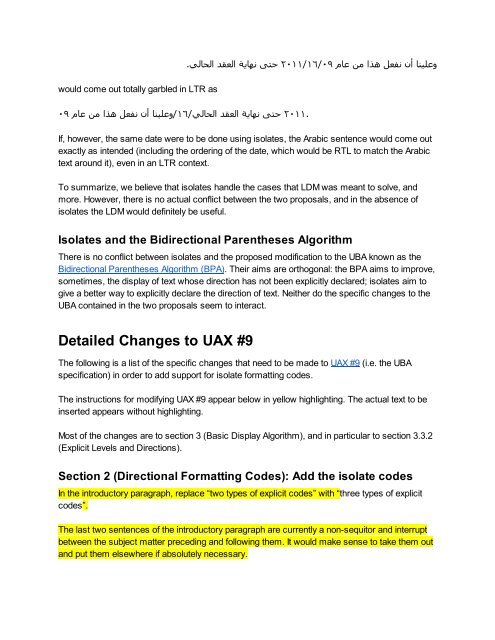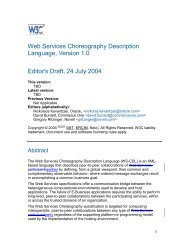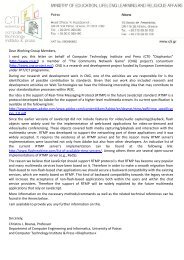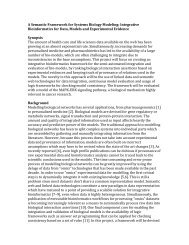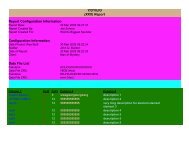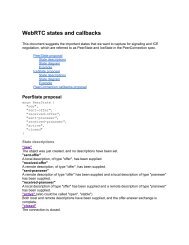A Proposal for Bidi Isolates in Unicode
A Proposal for Bidi Isolates in Unicode
A Proposal for Bidi Isolates in Unicode
You also want an ePaper? Increase the reach of your titles
YUMPU automatically turns print PDFs into web optimized ePapers that Google loves.
would come out totally garbled <strong>in</strong> LTR as<br />
وعلینا أن نفعل ھذا من عام ٢٠١١/١٦/٠٩ حتى نھاية العقد الحالي.<br />
.٢٠١١ حتى نھاية العقد الحالي/١٦/وعلینا أن نفعل ھذا من عام ٠٩<br />
If, however, the same date were to be done us<strong>in</strong>g isolates, the Arabic sentence would come out<br />
exactly as <strong>in</strong>tended (<strong>in</strong>clud<strong>in</strong>g the order<strong>in</strong>g of the date, which would be RTL to match the Arabic<br />
text around it), even <strong>in</strong> an LTR context.<br />
To summarize, we believe that isolates handle the cases that LDM was meant to solve, and<br />
more. However, there is no actual conflict between the two proposals, and <strong>in</strong> the absence of<br />
isolates the LDM would def<strong>in</strong>itely be useful.<br />
<strong>Isolates</strong> and the <strong>Bidi</strong>rectional Parentheses Algorithm<br />
There is no conflict between isolates and the proposed modification to the UBA known as the<br />
<strong>Bidi</strong>rectional Parentheses Algorithm (BPA). Their aims are orthogonal: the BPA aims to improve,<br />
sometimes, the display of text whose direction has not been explicitly declared; isolates aim to<br />
give a better way to explicitly declare the direction of text. Neither do the specific changes to the<br />
UBA conta<strong>in</strong>ed <strong>in</strong> the two proposals seem to <strong>in</strong>teract.<br />
Detailed Changes to UAX #9<br />
The follow<strong>in</strong>g is a list of the specific changes that need to be made to UAX #9 (i.e. the UBA<br />
specification) <strong>in</strong> order to add support <strong>for</strong> isolate <strong>for</strong>matt<strong>in</strong>g codes.<br />
The <strong>in</strong>structions <strong>for</strong> modify<strong>in</strong>g UAX #9 appear below <strong>in</strong> yellow highlight<strong>in</strong>g. The actual text to be<br />
<strong>in</strong>serted appears without highlight<strong>in</strong>g.<br />
Most of the changes are to section 3 (Basic Display Algorithm), and <strong>in</strong> particular to section 3.3.2<br />
(Explicit Levels and Directions).<br />
Section 2 (Directional Formatt<strong>in</strong>g Codes): Add the isolate codes<br />
In the <strong>in</strong>troductory paragraph, replace “two types of explicit codes” with “three types of explicit<br />
codes”.<br />
The last two sentences of the <strong>in</strong>troductory paragraph are currently a non-sequitor and <strong>in</strong>terrupt<br />
between the subject matter preced<strong>in</strong>g and follow<strong>in</strong>g them. It would make sense to take them out<br />
and put them elsewhere if absolutely necessary.


